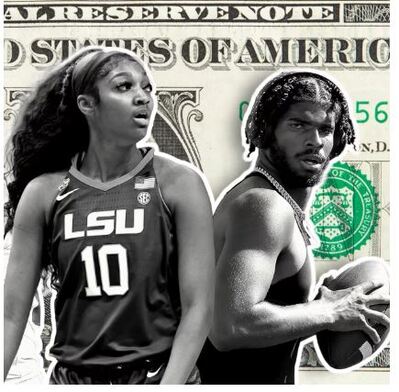|
By: Milith Batchu  The introduction of Name, Image, and Likeness (NIL) rights has been a game changer in college sports. Since the NCAA’s 2021 policy adjustment, college athletes are now allowed to profit from their NIL without risking their sports eligibility. But what stands for the new era in college sports and what other possibilities or challenges could arise? The answers will have major implications for collegiate athletics. Past & Present: The Landscape of NIL in College Sports
The NIL era has ushered in a variety of endorsement deals for college athletes. High-profile athletes like 2021 Heisman Winner, Bryce Young, have landed deals that value over $1 million. Meanwhile, Caitlin Clark, the former Iowa basketball star turned Indiana Fever first overall draft pick, has used her legendary college career to secure lucrative contracts with big name brands like her eight-figure Nike shoe deal alongside State Farm, Gatorade, and Bose, showing that female athletes are also thriving under the new rules. The scope of these deals can vary greatly depending on the player and company. Some athletes might partner with local businesses for smaller endorsements, such as previously known Miami quarterback D’Eriq King, becoming the first athlete to do so, linking up with the Florida Panther NHL team, showing the diverse potential of NIL deals. Local communities and economies benefit as well from the likes of the Cavinder twins from Miami promoting local businesses, driving both community engagement and economic growth. Future Opportunities and Challenges In NIL As NIL continues to develop, more opportunities are expected to arise. Athletes are increasingly using platforms like Instagram and Tiktok to build their brands and engage with fans, which can significantly increase their marketability. Paige Bueckers of Uconn has effectively used her social media presence to gain a wide range of fans from all over the world. However, NIL also presents several challenges. Navigating complex state laws and regulations can be a daunting task for student-athletes, like former South Carolina quarterback Spencer Rattler, whose experiences with multiple brands across different states required numerous legal actions in pursuit of major deals. There are also concerns about the potential impact on the educational goals and academic performance of student-athletes, creating the need for effective support systems. Critics have expressed this concern that NIL could create an uneven playing field among athletes and schools, potentially leading to a decrease in the overall college sports quality. Issues like distractions from education and sports, potential exploitation, and impacts on team dynamics are all real-life considerations as we move forward. Scenarios for the Future Looking onwards, NIL could lead to a more equitable environment where athletes across different sports and divisions of college could benefit from certain endorsements. Advocates of this idea could help drive changes that increase fairness and increase player commitment to the game everyone loves. Alternatively, the future might see greater financial disparities between top-earning athletes and their peers, increasing the gap between teams and universities. So what? The lack of uniform federal regulation and the inconsistent pieces of legislation in state law pose challenges to NIL. A controlled approach could, however, help mitigate the risks of NIL deals, which would prevent favoring the rich, powerful sports programs. NIL policies have permanently altered the college sports scene as we know it. Progress can be tough at times, making it crucial to balance commercial interests with the welfare of student-athletes and the integrity of the NCAA. With careful oversight and cooperation from fans, players, staff, board members, NIL can provide significant benefits without losing any of the established quality of play people adore.
0 Comments
Leave a Reply. |
Archives
May 2024
|